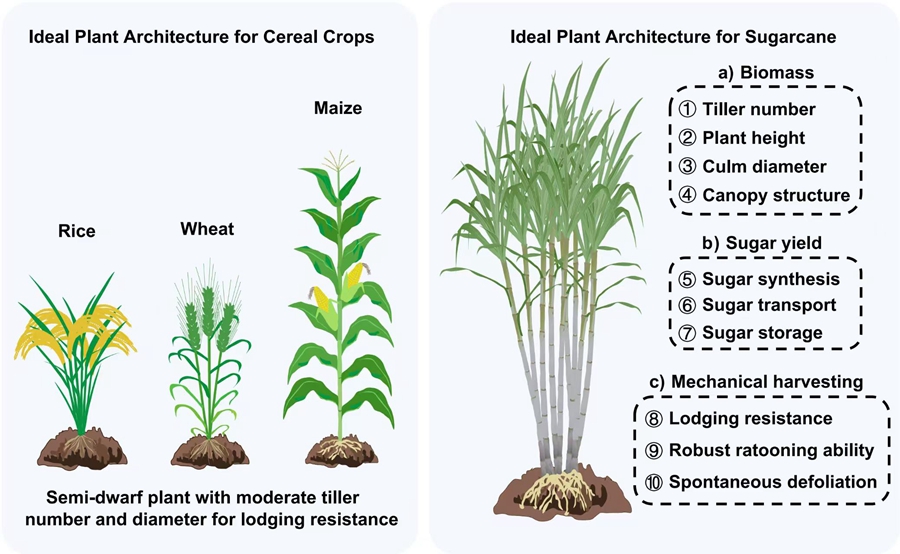In a study published in Molecular Plant on April 8, researchers led by Prof. WANG Bing and Prof. LI Jiayang from the Institute of Genetics and Developmental Biology (IGDB) of the Chinese Academy of Sciences (CAS) have proposed an innovative concept of "ideal plant architecture for sugarcane" and discussed the challenges, opportunities, and strategies for shaping it.
This study provides new insights for achieving breakthroughs in sugarcane yields and has significant implications for ensuring global sugar security.
Sugarcane (Saccharum spp. hybrid) is one of the world's most economically significant crops, contributing ~80% of global sugar production and 40% of fuel ethanol. Improving sugarcane yield is essential to ensure sugar security and promote bio-economic development. Plant architecture, the three-dimensional structural feature formed during morphogenesis, has a profound effect on crop yield and thus serves as a core element in high-yield breeding. However, due to limitations such as the highly complex sugarcane genome, narrow genetic background, and long breeding cycles, the dissection and application of architecture improvement in sugarcane breeding have lagged behind, leaving significant untapped potential for yield improvement.
Ideal Plant Architecture (IPA) is the morphological and structural characteristics of plants that enable them to achieve maximum population potential in a given environment. This concept was proposed by Prof. LI Jiayang and validated by the cloning of the IPA1 gene in rice. It provides guidance and reference for genetic improvement and breeding by design in a wide range of crops. The shaping of sugarcane IPA must revolve around its growth characteristics and target economic traits, including maximizing stalk biomass, increasing sugar content, and adapting to efficient mechanized harvesting. The proposed sugarcane IPA includes six critical traits: uniform tillering with minimal non-productive shoots, thick and upright stalks, optimized canopy structure, strong resistance to lodging, robust ratooning ability, and spontaneous leaf shedding at maturity. Together, these characteristics form a blueprint for high-yield, sustainable, and mechanization-friendly sugarcane production.
While the theoretical yield potential of sugarcane is estimated at 380 tons per hectare, actual yields typically hover around 80 tons per hectare—highlighting a substantial opportunity for yield enhancement through architectural optimization.
Recent breakthroughs in genomics, phenomics, and genome editing technologies offer unprecedented opportunities for improving sugarcane architecture. High-quality reference genomes and pan-genome studies have laid the foundation for identifying architecture-regulating genes, and genome editing technology enables precise modulation of gene dosage in polyploid sugarcane. De novo domestication of wild sugarcane germplasm can rapidly develop new varieties with both desirable yield traits and high stress resistance. Molecular breeding by design allows targeted optimization of the architecture and can significantly improve breeding efficiency. Artificial intelligence is revolutionizing sugarcane breeding by integrating multi-source data and enabling accurate phenotype prediction.
These innovative approaches offer a transformative pathway for closing the yield gap and enhancing global sugar security. Furthermore, the sugarcane IPA concept provides a valuable reference for architectural improvement and molecular breeding by design in other high-biomass, polyploid crops.
This study was supported by the Strategic Priority Research Program of CAS, the National Natural Science Foundation of China, and the Youth Innovation Promotion Association of CAS.
Ideal plant architecture for sugarcane and other cereal crops (Image by IGDB)





